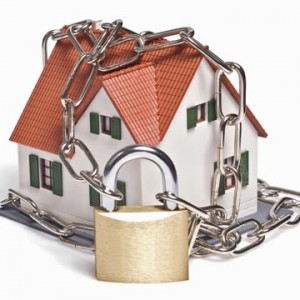One of the most important techniques to protecting your home is creating tiered security. It’s not very difficult for a burglar to get past one line of defense. The more difficult it is and the longer it takes a burglar to break into your home, the more likely they’ll run away. Neighbors are also more likely to spot someone breaking in if you are able to slow any potential thieves down. Adding additional tiers of security can easily mean the difference between staying protected and a potential robbery.
The first tier is your exterior. Make sure your exterior is well maintained and looks occupied, even if you’re away. Unmowed lawns, newspapers on the porch, and mail piling up are all signs that no one is watching the house. Motion detector lights and well trimmed bushes/hedges protect you from people sneaking onto your property. If you need to leave a spare key outside, make sure it is well hidden and not in commonly checked places (under the mat, in the mailbox, under an out of place fake rock). For the most effective security, external weatherproofed security cameras with a 24 hour monitoring company can provide a high level of protection.
Your house itself is your next tier. About 85% of burglaries take place with the thief entering through the front or back door. About 60% of break ins are accomplished using force. Replace hollow doors with solid-core doors, add a dead-bolt, and reinforce the door jamb with metal. Adding a security film to windows will make them much more difficult to break. Most importantly, make sure all windows and doors are locked when you leave the house, even for a quick trip to the store. 30% of burglaries occur through an unlocked window or door.
Inside your house is the most critical tier. Use thick drapes and keep valuables out of view so burglars can’t see inside what you have inside your house. Electronics and jewelry are often the most sought-after items for criminals. Identify theft is also one of the fastest growing crimes. Make sure these valuable assets are protected – a large heavy Internal motion detectors, glassbreak detectors, and video cameras on an alarm system provide a comprehensive defense against potential burglaries.
While the physical barriers to a burglar getting in is extremely important, another aspect to remember is the psychological defenses. Signs and stickers that an alarm system is installed in the house are great deterrents. A dog is also a very large reason many potential burglars would avoid a house – even if you don’t have one, making it look like you do by posting a sign or leaving a leash outside can help. Audible alarm systems are not just to alert you or neighbors to a potential intruder, but also to scare away anyone that has made it into your house.


 The images above show the difference between a parking garage being monitored by a camera with no WDR or WDR turned off on the left, and on the right the same area monitored by a camera with WDR enabled. The difference is clear as day. Why do they differ so much? The camera with the WDR enabled has two internal Charge-Coupled Devices (CCD). The two devices, or sensors, scan an image at different speeds, one low and one high, the image processor then combines the separate images producing a clearer, more balanced picture with better contrast and lighting. This process happens quickly enough to produce a stream of clear recorded footage. There are many different manufacturers that produce these WDR cameras in the market today, and not all of them use the same type of sensor and image processing combinations. The best way to ensure you are getting the best camera for your specific application is to hire a licensed security systems integrator who is educated in which camera specifications will work best in variant conditions.
The images above show the difference between a parking garage being monitored by a camera with no WDR or WDR turned off on the left, and on the right the same area monitored by a camera with WDR enabled. The difference is clear as day. Why do they differ so much? The camera with the WDR enabled has two internal Charge-Coupled Devices (CCD). The two devices, or sensors, scan an image at different speeds, one low and one high, the image processor then combines the separate images producing a clearer, more balanced picture with better contrast and lighting. This process happens quickly enough to produce a stream of clear recorded footage. There are many different manufacturers that produce these WDR cameras in the market today, and not all of them use the same type of sensor and image processing combinations. The best way to ensure you are getting the best camera for your specific application is to hire a licensed security systems integrator who is educated in which camera specifications will work best in variant conditions.

